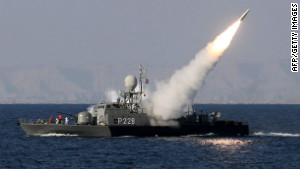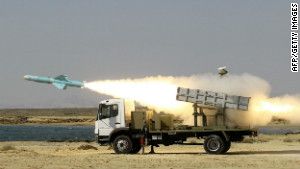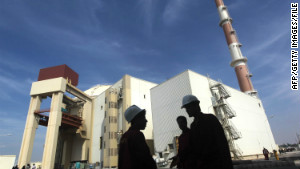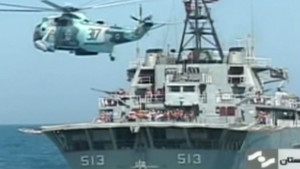(CNN) -- Iran warned the United States Tuesday not to return a U.S. aircraft carrier "to the Persian Gulf region."
U.S. officials rejected the "warning" and another recent threat from Tehran that it could close the Strait of Hormuz. The White House and U.S. State Department called the latest threats signs that sanctions against Iran, the result of a standoff over its nuclear activities, are working.
"The Islamic Republic of Iran will not repeat its warning," said Maj. Gen. Ataollah Salehi, commander of Iran's Army, according to the state-run news agency IRNA.
Salehi "said the country will not adopt any irrational move but it is ready to severely react against any threat," the report added.
The commander spoke at the Port of Chabahar in southern Iran, as forces held a military parade the day after Iran ended naval drills in the region, IRNA reported.
 What's Iran's real plan?
What's Iran's real plan?
 U.S. sanctions hurting Iran's currency
U.S. sanctions hurting Iran's currency
 Report: Iran tests nuclear fuel rod
Report: Iran tests nuclear fuel rod
 Navy won't tolerate Iran 'disruption'
Navy won't tolerate Iran 'disruption'
Iran was referring to the USS John C. Stennis, part of the U.S. Navy's fleet in the region. It moved last week from the Persian Gulf into the North Arabian Sea, as part of what the Navy's 5th Fleet called a pre-planned transit.
Iran said the ship's movement during Iran's naval exercises showed that the United States "understood" that Iran's maneuvers were not "suicidal or aggressive," but rather about Iran protecting its own "interests and power."
But Western diplomats last week described the naval drills -- which, according to Iranian officials, included test-firing missiles -- as further evidence of Iran's volatile behavior.
Iran's naval exercises began in the strait and also included waters in the Sea of Oman and the Indian Ocean up to the Gulf of Aden, according to IRNA.
After Tuesday's warning from Iran, a Pentagon spokesman issued a statement saying "deployment of U.S. military assets in the Persian Gulf region will continue as it has for decades."
"These carrier strike group deployments are necessary to maintain the continuity and operational support to ongoing missions in the U.S. Central Command area of responsibility," George Little said.
The United States has had forces in the Persian Gulf since World War II. Its ships sail through the Persian Gulf frequently, many on their way to and from the 5th Fleet's headquarters in Bahrain. The 5th Fleet's area of responsibility covers about 2.5 million square miles, including the Persian Gulf, which the Navy also refers to as the Arabian Gulf; the Red Sea; the Gulf of Oman and parts of the Indian Ocean.
The dispute over the Stennis began last week. Tehran said an Iranian warplane identified a U.S. carrier patrolling the area of the drills. State-run media showed a picture of the vessel.
Iran's state-run Press TV said Tuesday the images it showed last week were of the Stennis.
Tuesday's events came amid growing tensions over the Strait of Hormuz, a critical shipping channel.
Iran last week threatened to block the strait if sanctions are imposed on its oil exports. France, Britain and Germany have proposed sanctions to punish Iran's lack of cooperation on its nuclear program.
Cmdr. Amy Derrick Frost, spokeswoman for the 5th Fleet in Bahrain, responded at the time, "Anyone who threatens to disrupt freedom of navigation in an international strait is clearly outside the community of nations; any disruption will not be tolerated."
In his statement Tuesday, Pentagon spokesman Little said the Navy "operates under international maritime conventions to maintain a constant state of high vigilance in order to ensure the continued, safe flow of maritime traffic in waterways critical to global commerce.
"Our transits of the Strait of Hormuz continue to be in compliance with international law, which guarantees our vessels the right of transit passage. We are committed to protecting maritime freedoms that are the basis for global prosperity; this is one of the main reasons our military forces operate in the region."
The dispute has been pushing up oil prices. Nearly 17 million barrels of oil a day pass through the strait, according to the U.S. Energy Information Agency. "Flows through the Strait in 2011 were roughly 35% of all seaborne traded oil, or almost 20% of oil traded worldwide," the agency says.
"No one in this government seeks confrontation over the Strait of Hormuz," Little said. "It's important to lower the temperature."
But closing the strait would require means that likely are not available to Iran, said Jean-Paul Rodrigue, an expert in transport geography at Hofstra University. "At best, Iran can posture and potentially disrupt traffic for a short duration," he said.
China and Japan are more dependent on Persian Gulf oil than the United States is, he said, and he added that any move to close the strait would be "suicidal" to the current regime.
U.S. State Department spokeswoman Victoria Nuland noted Tuesday that Iran is already under sanctions for its failure to cooperate on nuclear issues.
"Frankly, we see these threats from Tehran as just increasing evidence that the international pressure is beginning to bite there and that they are feeling increasingly isolated and they are trying to divert the attention of their own public from the difficulties inside Iran, including the economic difficulties as a result of the sanctions," she said.
White House spokesman Jay Carney made similar remarks. "I think it reflects the fact that Iran is in a position of weakness. It's the latest round of Iranian threats, and it's confirmation that Tehran is under increasing pressure for its continued failures to live up to its international obligation," he said. "Iran is isolated and is seeking to divert attention from its behavior and domestic problems. This is simply a measure of the impact that sanctions have been having on Iran and the broad international support for... putting pressure on Iran and isolating Iran because of its refusal to live up to its international obligations."

